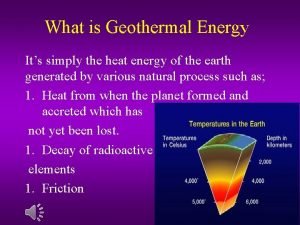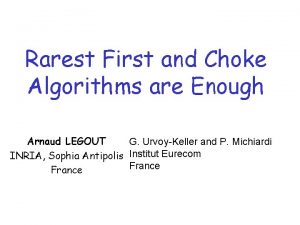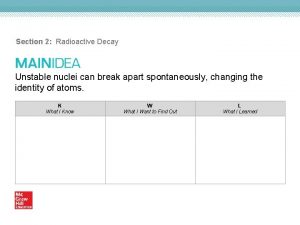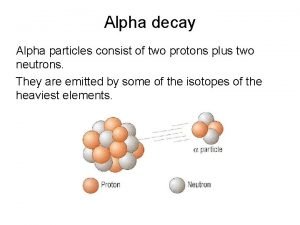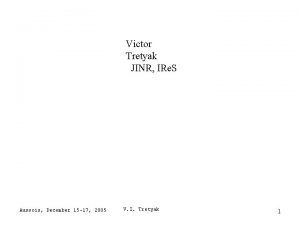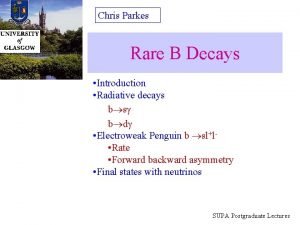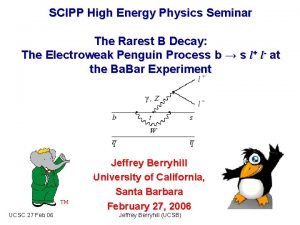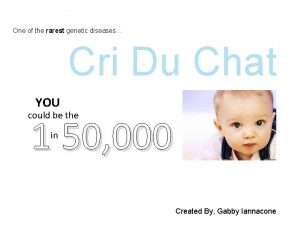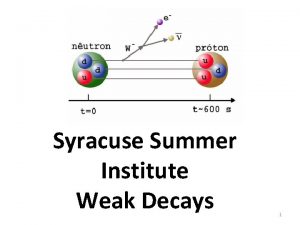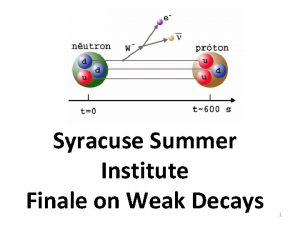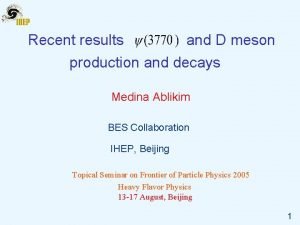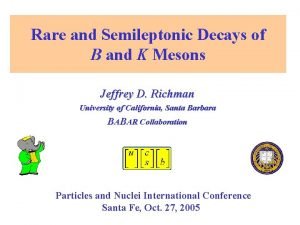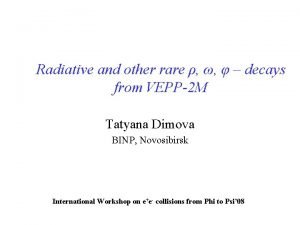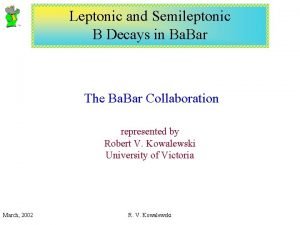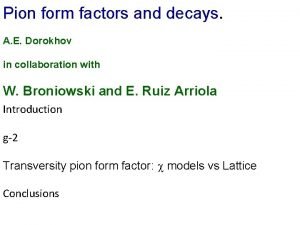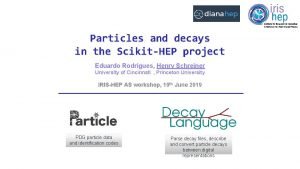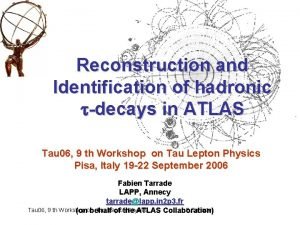Rarest and decays V I Tretyak Institute for






















































- Slides: 54

Rarest and decays V. I. Tretyak Institute for Nuclear Research, Kyiv, Ukraine Institute for Basic Science, Daejeon, Korea, 10. 02. 2015 1

1. Introduction 2. Recent searches and discoveries of rare decays (151 Eu, 180 W, 178 m 2 Hf*, 190 Pt*, 204, 206, 207, 208 Pb, 209 Bi*) 3. Investigations of rare decays (48 Ca, 50 V, 96 Zr, 113 Cd, 115 In*, 123 Te, 180 m. Ta, 222 Rn) 4. Observation of emission of e+e pairs in decay of 241 Am 5. Conclusions 2

1. Introduction 3

Classification of radioactive decays: Old known , , decays : (A, Z) (A 4, Z 2), starting from 106 Te to superheavy; T 1/2 from 10 8 s (217 Ac) to 1019 y (209 Bi) : (A, Z) (A, Z 1), from 3 H; from 10 2 s (11 Li) to 1016 y (113 Cd) : (A, Z)* (A, Z), from 10 12 s to 105 y (186 m. Re) Cluster decays: emission of nuclides heavier than particle, from 14 C to 34 Si (~40 mothers from 221 Fr to 242 Cm, residue close to double magic 208 Pb – “lead radioactivity”), 103 1020 y; predicted in 1980 (or earlier? ), observed in 1984 2 decays: allowed in SM 2 2 in 13 nuclei (48 Ca, 76 Ge, 82 Se, 96 Zr, 100 Mo, 116 Cd, 128 Te, 130 Te, 136 Xe, 150 Nd, 238 U + 78 Kr, 130 Ba), 1018 1024 y; forbidden in SM 2 0 T 1/2>1025 y (in best cases of 76 Ge, 136 Xe; claim for observation in 76 Ge) Spontaneous fission: heavy nuclei from 232 Th; T 1/2 from 10 3 s (264 Hs) to 1019 y (235 U) p, 2 p, 3 p, 2 n, …: in short living isotopes (~40 mothers); from ps to s 4

2. Recent searches and discoveries of rare decays Recently discovered decays: 2003 – 209 Bi 2003 – 180 W 2007 – 151 Eu 2007 – 178 m 2 Hf* 2011 – 190 Pt* 2012 – 209 Bi* Limits: 2012 – 151 Eu* 2013 – 204, 206, 207, 208 Pb 5

Until 2003, 209 Bi was considered as the heaviest stable isotope. However, in 2003 its alpha decay was discovered by P. De Marcillac et al. , Nature 422 (2003) 876. To-date, it has the longest T 1/2 1019 y (for g. s. to g. s. transition). decays 6

209 Bi P. De Marcillac et al. , Nature 422(2003)876 Bi 4 Ge 3 O 12 scintillating bolometer 46 g, 20 m. K (for 209 Bi - =100%) Heat and light signals – discrimination of and / events by ratio of light/heat Measurements (at Earth level) – 5 days, 128 observed events at Q = 3. 137 Me. V T 1/2 = (1. 9 0. 2)× 1019 y – the biggest half life ever measured for decays (g. s. to g. s. ) 7

180 W F. A. Danevich et al. , Phys. Rev. C 67(2003)014310 Cd. WO 4 scintillator, 330 g Solotvina underground laboratory (Ukraine, 1000 m w. e. ) 2975 h of measurements in low background set-up Cd. WO 4 crystals, Lviv, Ukraine, 2002 Pulse shape discrimination between and / events thanks to different evolution of scintillating signal in time: Q = 2. 516 Me. V 180 W ( = 0. 12%) 8

Quenching of scintillation signals from alpha particles (observed energy of ’s is ~0. 14 of their real energy): The effect is observed, T 1/2 = (1. 1+0. 9 0. 5) 1018 y (1) Peak belongs to particles (thanks to pulse-shape discrimination) (2) Correct energy 9 (3) T 1/2 in agreement with theoretical expectations

Confirmation: C. Cozzini et al. , Phys. Rev. C 70(2004)064606 CRESST, Ca. WO 4 scintillating bolometer 300 g, ~15 m. K, FWHM = ~18 ke. V, ~2300 h of measurements, low background set-up at LNGS (3600 m w. e. underground) T 1/2 = (1. 8 0. 2) 1018 y Measured Q = 2516. 4 1. 1(stat) 1. 2(syst) ke. V Further observations: T 1/2 = (1. 0+0. 7 0. 3) 1018 y – Ca. WO 4, Yu. G. Zdesenko et al. , NIMA 538(2005)657 (1. 3+0. 6 0. 5) 1018 y – Zn. WO 4, P. Belli et al. , NIMA 626 -627(2010)31 Now it is routine observation in many rare events’ experiments. 10

151 Eu P. Belli et al. , Nucl. Phys. A 789(2007)15 decay 151 Eu (5/2+) 147 Pm (7/2+), = 47. 81%, Q = 1. 964 Me. V Our theoretical estimations with few models: T 1/2 = 3. 0 1017 3. 6 1018 y The effect could be observed with Ca. F 2(Eu) scintillator with 0. 4% Eu. LNGS (3600 m w. e. ), low background set-up, 7426 h, Ca. F 2(Eu) 370 g / ratio = 0. 13 expected energy for 151 Eu ~250 ke. V 147 Sm: Pulse shape discrimination between and / events: 11

Experimental spectrum and its fit by simulated distributions: Spectra: total and divided on and components Peak’s energy: 255 7 ke. V E =1. 98 0. 04 Me. V (expected E =1. 912) Number of 151 Eu nuclei (ICP-MS): (2. 8 0. 7) 1021; S = 302 232 counts T 1/2 = 5+11 3 1018 y Later calculations: 8. 5 1018 y – O. A. P. Tavares et al. , Phys. Scr. 76(2007)C 163 1. 3 1018 y – Y. B. Qian et al. , Phys. Rev. C 84(2011)064307 1. 0 1019 y – Y. B. Qian et al. , Phys. Rev. C 85(2012)027306 12 8. 0 1017 y – K. P. Santhosh et al. , Int. J. Mod. Phys. E 22(2013)1350081

Confirmation: N. Casali et al. , J. Phys. G 41(2014)075101 LUCIFER, Li 6 Eu(BO 3)3 scintillating bolometer 6. 15 g, FWHM = 65 ke. V, 462 h of measurements, low background set-up at LNGS (3600 m w. e. underground) S = 38 8, T 1/2 = (4. 6 1. 2) 1018 y Measured Q = 1948. 9 8. 6 ke. V 151 Eu L. Pattavina, talk at RPScint’ 2013 workshop, Kyiv, 17 -20. 09. 2013 Excellent discrimination of / events from events 147 Sm 13

204, 206, 207, 208 Pb J. W. Beeman et al. , Eur. Phys. J. A 49(2013)50 All naturally occuring Pb isotopes are potentially decaying, Q = 0. 392 – 1. 970 Me. V. Theoretical expectations: T 1/2 = 1035 10189 y. LUCIFER, Pb. WO 4 scintillating bolometer (with ancient Roman lead: activity of 210 Pb < 4 m. Bq/kg, while for usual Pb it is ~ 102 – 103 Bq/kg), 454 g, LNGS (3600 m w. e. ), low background set-up, 586 h Only limits are derived: T 1/2 > 1. 4 1020 – 2. 6 1021 y (for 204 Pb – 3 orders of magnitude better than previous exp. limit) 14

Observations of rare g. s. to g. s. decays (in sports terminology): Half life, y Activity, decays in 1 g of element (of natural isotopic composition) during 1 year 209 Bi 151 Eu 180 W 1. 9 1019 5 1018 209 Bi 180 W 2. 3 105 151 Eu 1. 2 1018 263 1 2 KINR ROSE& DAMA BUD 1 3 KINR 2 3 ROSEBUD KINR & DAMA (209 Bi) = 100% (151 Eu) = 47. 81% (180 W) = 0. 12% 15

178 m 2 Hf 174 Yb* 178 m 2 Hf – extremely interesting nucleus: Eexc = 2446 ke. V but T 1/2 = 31 y S. A. Karamian et al. , PRC 75(2007)057301 Usually it decays through IT, but potentially it is decaying, Q=4526 ke. V; several excited levels of 174 Yb can be populated. most prob able First observed in 2007: source with 3. 5 1013 nuclei of 178 m 2 Hf (176 Yb target exposed to 36 Me. V He ion beam) deposited on thin Be foil between 2 CR-39 foils, ~1 y exposure, observation of tracks after CR -39 etching. 16 Result: 307 ( 25? ) events in excess, T 1/2* = (2. 5 0. 5) 1010 y

190 Pt 186 Os* (Eexc=137. 2 ke. V) P. Belli et al. , PRC 83(2011)034603 G. s. to g. s. decay 190 Pt 186 Os is known since 1921: Q=3251 ke. V, T 1/2=(6. 5 0. 3) 1011 y; Transition to the 1 st excited level was observed only in 2011 LNGS (3600 m w. e. ), HPGe 468 cm 3, low background set-up, 1815 h, 42. 5 g of natural Pt (190 Pt: =0. 014%; new value (2011) =0. 012%) Measured energy = 137. 1 0. 1 ke. V Peak =132 17 counts (8 effect) The peak is absent in background T 1/2* = 2. 6+0. 4 0. 3(stat) 0. 6(syst) 1014 y 17

Old and new schemes of 190 Pt decay T 1/2 limits for other Pt isotopes were also set at the level of 1016 – 1020 y It would be nice to remeasure with different detector and Pt sample 18

209 Bi 205 Tl* (Eexc=204 ke. V) J. W. Beeman et al. , PRL 108(2012)062501 G. s. to g. s. decay 209 Bi 205 Tl – 2003: Q=3137 ke. V, T 1/2=(1. 9 0. 2)e 18 y Transition to the 1 st excited level was observed in 2012 LNGS (3600 m w. e. ), Bi 4 Ge 3 O 12 bolometer 889 g, few tens m. K, 375 h Heat and light signals – discrimination of and / events by ratio of light/heat g. s. : + recoil (3137 ke. V) 204 ke. V: + recoil (2933 ke. V) + (204 ke. V) The same heat signals, but different light signals because scintillation from is quenched, and from not quenched T 1/2 = (2. 04 0. 08) 1019 y T 1/2* = (1. 4 0. 2) 1021 y 19

151 Eu 147 Pm* (Eexc=91 ke. V) F. A. Danevich et al. , EPJA 48(2012)157 G. s. to g. s. decay: T 1/2 ~ 5 1018 y Decays to excited levels are also possible, the most probable to 1 st level, Eexc=91 ke. V HADES (500 m w. e. ), high purity Eu 2 O 3 303 g, 2233 h in low-background set-up with HPGe 40 cm 3 The effect is absent, only limit: T 1/2 > 3. 7 1018 y ~1 order of magnitude better than previous exp. limits Not far from theor. estimates 1019 1020 y 20

3. Investigations of rare decays 48 Ca 50 V 96 Zr 113 Cd 115 In* 123 Te 180 m. Ta 222 Rn 21

48 Ca Q =282 ke. V Could be populated: ground state J =6+ level 131 ke. V J =5+ level 252 ke. V J =4+ T 1/2 - theoretical estimates and experimental limits (y) (T 1/2 decreases for bigger Q as ~1/Q 5, but increases for bigger J ): 6+(g. s. ) 5+(131) 4+(252) Theory [1] =4. 0 e 25 =4. 0 e 22 =3. 0 e 23 Theory [2] =1. 5 e 29 -1. 3 e 31 =(1. 1+0. 8 -0. 6)e 21 =8. 8 e 23 -5. 2 e 26 Experiment [3] >1. 6 e 20 >2. 5 e 20 the most probable >1. 9 e 20 [1] R. K. Bardin et al. , NPA 158 (1970) 337 [2] M. Aunola et al. , Europhys. Lett. 46 (1999) 577 [3] A. Bakalyarov et al. , JETP Lett. 76 (2002) 545 (search for deexcitation ’s of 48 Sc, 48 Ti with Ge detector; however (48 Ca)=0. 187%) At the same time, 48 Ca can decay also through 2 decay to 48 Ti (2 nd order process); already observed in few experiments: T 1/2(2 2 , g. s. ) = 4. 3 e 19 y. 22 Thus single decay occurs even with lower probability than 2 decay - due to big J

96 Zr Q =161 ke. V Could be populated: ground state J =6+ level 44 ke. V J =5+ level 146 ke. V J =4+ T 1/2 - theoretical estimates and experimental limits (y): 6+(g. s. ) 5+(44) 4+(146) Theory [1] =1. 2 e 29 =2. 4 e 20 =4. 9 e 22 Experiment [2] >3. 8 e 19 the most probable >3. 8 e 19 [1] H. Heiskanen et al. , J. Phys. G 34 (2007) 837 [2] M. Arpesella et al. , Europhys. Lett. 27 (1994) 29 (search for deexcitation ’s of 96 Mo with Ge detector; (96 Zr)=2. 80% - much higher than that for 48 Ca; worth to remeasure with higher sensitivity? ) 2 decay of 96 Zr to 96 Mo: T 1/2(2 2 , g. s. ) =(2. 3 0. 4)e 19 y (NEMO-3’ 2008). Geochemical 2 T 1/2: =(3. 9 0. 9)e 19 Kawashima’ 1993 and =(0. 9 0. 3)e 19 Wieser’ 2001. Contribution of single decay to geochemical T 1/2? 23

180 m. Ta Extremely interesting case: g. s. state quickly decays (T 1/2~8 h); isomeric state (Eexc=77 ke. V) has very big T 1/2>2 e 16 y (180 m. Ta)=0. 012% EC J =3 Last experimental search: M. Hult et al. , Appl. Rad. Isot. 67 (2009) 918 1500 g of natural Ta, sandwich HP Ge, underground HADES laboratory (500 m w. e. ), 68 d T 1/2(EC) > 4. 5 e 16 y T 1/2( ) > 3. 7 e 16 y Theoretical T 1/2 estimations: IT > 1 e 27 y E. B. Norman, PRC 24(1981)2334 EC, calculations are absent 24

123 Te (123 Te)=0. 89% Many puzzling experimental situations (only K EC was searched for): 1. D. N. Watt et al. , Philos. Mag. 7 (1962) 105 Detection of Sb X rays EX=26. 1 ke. V after EC with prop. counter, T 1/2=(1. 24 0. 10)e 13 y This result was present in all nuclear tables many years 2. A. Alessandrello et al. , PRL 77 (1996) 3319 Four 340 g Te. O 2 bolometers, underground measurements (LNGS, 3600 m w. e. ), 1548 h Peak at total energy release of 30. 5 ke. V (EK of Sb) is observed, T 1/2 K=(2. 4 0. 9)e 19 y - 6 orders of magnitude higher! Result of Watt’ 1962 was explained by excitation of Te atoms by cosmic rays and nat. radioactivity that gives EX=27. 3 ke. V, and by not enough good resolution of prop. counter 3. A. Alessandrello et al. , PRC 67 (2003) 014323 Twenty 340 g Te. O 2 bolometers, LNGS (3600 m w. e. ), peak at 30. 5 ke. V is not present, T 1/2 K>5. 0 e 19 y ! However, this peak appeared once more after all crystals were dismounted for surface cleaning at the sea level for ~2 months period and reinstalled underground. Explanation of Alessandrello’ 1996: peak at 30. 5 ke. V is due to EC of 121 Te (Q=1036 ke. V, T 1/2=16. 78 d); 121 Te is produced by neutron capture on 120 Te ( =0. 09%) ! 25

50 V =0. 250% One of only 3 nuclei where processes with J =4+ were observed (other two are 113 Cd and 115 In) Low natural abundance ( =0. 250%), big T 1/2 (difficult to study) Experiment 1989: J. J. Simpson et al. , PRC 39 (1989) 2367 3 Ge detectors, 337. 5 g of natural V, salt mine, 1109 h Search for ’s of 1554 ke. V (EC) and 783 ke. V ( decay) Experiment 2011: H. Dombrowski et al. , PRC 83 (2011) 054322 Ge detector, 255. 8 g of natural V, Asse salt mine (1200 m w. e. ), 2347 h Peak 783 ke. V is not observed: T 1/2(EC)=(2. 3 0. 3)e 17 y, T 1/2( )>1. 7 e 18 y Only ’s are detected; T 1/2 is measured but not shape of spectrum 26

113 Cd =12. 22% 1/2+ 9/2+ J = 4+ classified as 4 FNU Was searched for since 1940, first observed in 1970, first measurement of shape in 1988 with Cd. Te detector One of the last experiments: P. Belli et al. , PRC 76 (2007) 064603 Cd. WO 4 scintillator 434 g, LNGS (3600 m w. e. ), 2758 h Experimental spectrum (S/B ratio = 1/50) and its fit by: 2. 4 e 6 events Kurie plots not accounting and accounting for correction factor C(w) Big statistics, purity of crystal lead to determination of T 1/2 with small uncertainty: T 1/2=(8. 04 0. 05)e 15 y 27

Experimental spectrum is excellently described as 3 FU ( J = 4 ): C(E) = P 6+c 1 P 4 Q 2+c 2 P 2 Q 4+c 3 Q 6 with c 1 = 7. 112, c 2 = 10. 493, c 3 = 3. 034 (small puzzle …) Recent theoretical description as 4 FNU: M. T. Mustonen et al. , PRC 73 (2006) 054301 + PRC 76 (2007) 019901(E) M. T. Mustonen et al. , PLB 657 (2007) 38 (shape different from the experimental one) Last experimental work: J. V. Dawson et al. , NPA 818 (2009) 264 16 Cd. Zn. Te detectors, LNGS, 6. 58 kg d Confirmed T 1/2 and shape of spectrum, but gave different Q value (322 ke. V instead of 345 ke. V in Belli’ 2007) (another small puzzle …) 28

115 In =95. 71% 9/2+ 1/2+ J = 4+ classified as 4 FNU On contrary to 113 Cd, spectrum shape was measured only in one work: L. Pfeiffer et al. , PRC 19 (1979) 1035 Liquid scintillator loaded by In at 51. 2 g/l, measurements at the sea level What could be improved: (1) Background, in particular n capture by 115 In (and 116 In is unstable, Q=3275 ke. V) (2) Strong quenching of low-energy electrons in liquid scintillator (was not discussed) (3) Response function (resolution) “is not known and is not readily measurable” (4) Q value was obtained as 492. 7(13. 6) ke. V and 470. 6(5. 2) ke. V; today value is 499(4) ke. V (5) T 1/2=(4. 41 0. 24)e 14 y (since 1979 – in all tables), but in some disagreement with previous results (f. e. G. B. Beard et al. , PR 122 (1961) 1576: T 1/2=(6. 9 1. 5)e 14 y) (6) Energy threshold – around 50 ke. V (7) Shape is described as polynomial in E Remeasuring in low background conditions would be very interesting! Recent theoretical description as 4 FNU: M. T. Mustonen et al. , PRC 73 (2006) 054301 + PRC 76 (2007) 019901(E) M. T. Mustonen et al. , PLB 657 (2007) 38 29

115 In 115 Sn* First observation of decay of 115 In to the first excited level (Eexc=497. 4 ke. V) of 115 Sn: C. M. Cattadori et al. , NPA 748 (2005) 333 + Phys. At. Nucl. 70 (2007) 127 LNGS, ~1 kg In, 4 HP Ge detectors 225 cm 3 each, 2762 h In + 1601 h background De-excitation ’s give peak at 497. 4 ke. V (observation with 4 ’s), (1. 18 0. 31)e-6 yield, T 1/2=(3. 7 1. 0)e 20 y Situation in 2005: Implications for neutrino mass: Ma = 499± 4 ke. V (Audi et al. , 2003) Q * = Ma Eexc = 1. 6± 4 ke. V our calculation: Q * = 460 e. V (possibly the lowest known measured Q value) Evidently: m <Q Could be Q ~1 e. V? Need to re-measure Ma (115 In 115 Sn, =4 ke. V) and E exc ( =22 e. V) with greater accuracy E. G. Myers, Florida St. Un. : 30 Ma with ~10 e. V for A=100

Subsequent events: 1. Confirmation of observation of 115 In 115 Sn* decay HADES underground laboratory (500 m w. e. ), 2566 g of In, 3 Ge: T 1/2=(4. 1 0. 6)e 20 y (E. Wieslander et al. , PRL 103(2009)122501) T 1/2=(4. 3 0. 5)e 20 y (E. Andreotti et al. , PRC 84(2011)044605) 2. New measurements of difference of 115 In 115 Sn masses = 497. 680 0. 170 ke. V (E. Wieslander et al. , PRL 103(2009)122501) = 497. 489 0. 010 ke. V (B. J. Mount et al. , PRL 103(2009)122502) Thus, Q* value is: Q* = Eexc = (497. 334 0. 022) (497. 489 0. 010) = 155 24 e. V Really the lowest Q value of a known decay (163 Ho – 2. 555 ke. V, 187 Re – 2. 469 ke. V) (and highest (partial) T 1/2) Paradoxical situation: masses of the nuclei (~100 Ge. V) are known with precision 10 e. V while Eexc (~500 ke. V) with precision 22 e. V (needs to be remeasured) 3. Influence of different chemical environment on T 1/2 (In, In. Cl 3, etc. ). If to use dependence T 1/2~1/Q 5 and change Q on 1 e. V only, we will obtain (155/154)5=1. 03 – 3% change in T 1/2. Difficult but maybe possible to see (current accuracy – 12%). 4. Deviations from theoretical spectrum due to non-zero mass? Theoretical spectrum ( J = 3+ – classified as 2 FU) was calculated in R. Dvornicky, F. Simkovic, AIP Conf. 31 Proc. 1417(2011)33. Very difficult experimentally.

222 Rn P. Belli et al. , Eur. Phys. J. A 50(2014)134 Ba. F 2 scintillator, 1. 714 kg, LNGS (3600 m w. e. ), 101 h. High contamination by 226 Ra – 7. 8 Bq/kg. In all nuclear tables, 222 Rn (in chain of 238 U) is 100% decaying. Usual chain: However, decay of 222 Rn also is energetically allowed with Q=24 21 ke. V. In this case: 222 Fr(2 ), J =2 ; T 1/2 can be estimated using average (for 216 known 1 FU decays) log ft = 9. 5 and LOGFT tool at NNDC as T 1/2 = 4. 8 105 y (for Q=24 ke. V; 6. 7 104 y for Q=45 ke. V and 2. 4 108 y for Q=3 ke. V). 222 Rn(0+) 32

Expected E and t are known, and it is possible to distinguish between and events in Ba. F 2 scintillator because of difference in their time shapes. The following sequence of events was searched for (222 Fr 222 Ra 218 Rn 214 Po): (1) event at 30 – 2207 ke. V (222 Fr Q + FWHM ) and with time shape; (2) next event at 2109 – 2623 ke. V (222 Ra E FWHM in scale), with time shape and in time interval [1. 65 ms, 1. 65 ms + 5 38. 0 s]; (3) last event at 2398 – 2946 ke. V (218 Rn E FWHM in scale), with time shape and in time interval [1. 65 ms, 1. 65 ms + 5 35 ms]. 7. 0 105 selected potential 218 Rn events. Maximal effect consistent with exp. data, T 1/2 > 122 d (too conservative limit) Limit from fit by model (known peaks from contamination), T 1/2 > 8. 0 y. 33

4. Observation of emission of e+e pairs in decay of 241 Am 34

R. Bernabei et al. , EPJA 49 (2013) 64 decay - internal bremsstrahlung (IB) and internal pair production (IPP) are known effects IB is known; what about IPP? In fact, it was observed previously in 3 experiments (1973, 1986, 1990): [2] A. Ljubicic, B. A. Logan, Phys. Rev. C 7 (1973) 1541 [6] K. Pisk et al. , Phys. Rev. C 17 (1978) 739 [10] J. Stanicek et al. , Nucl. Instrum. Meth. B 17 (1986) 462 [16] T. Asanuma et al. , Phys. Lett. B 237 (1990) 588 Theory, which describes the effect as creation of bremsstrahlung during acceleration with E > 1. 022 Me. V which borns e+e , 35 gives value of a correct order of magnitude.

In the DAMA experiment [R. Bernabei et al. , Int. J. Mod. Phys. A 28 (2013) 1330022], 241 Am sources are used for weekly calibrations. So, an idea appeared to check the old -IPP results, at the first time deep underground (avoiding influence of cosmic rays) and in lowbackground high-pure set-up (suppressing presence of + contaminations). DAMA/LIBRA: 25 Na. I(Tl) scintilaltors, 9. 70 kg each, 10. 2 25. 4 cm. 1 st run: 6 241 Am sources and 6 Na. I(Tl) pairs (all other Na. I(Tl)’s – as anticoincidence); 1. 29 d with 241 Am and 24. 6 d background; total 241 Am activity 200. 8 k. Bq; result: excess rate of double coincidences in 465557 ke. V ( 2 region) s = 4. 87 0. 87 counts/d/Na. I(Tl)pair 2 nd run: 3 241 Am sources and 3 Na. I(Tl) pairs, 2. 63 d (241 Am) + 24. 6 d (bkg), 98. 9 k. Bq, s = 5. 23 0. 90 counts/d/Na. I(Tl)pair 36

Exp. spectrum with 241 Am Exp. background Simulated 241 Am decay Simulated e+ annihilation Analysis of data: presence of 243 Am, 233 Pa, 154 Eu Spectrum of one Na. I(Tl) when energy of second is 465 -557 ke. V S=220 30 counts =(4. 70 0. 63) 10 9 37

Many possible mimicking contributions were analyzed and excluded: - + emitters in chain 241 Am … 209 Bi; - high energy rays in chain 241 Am … 209 Bi; - decays of 241 Am to high energy levels of 237 Np; - ( , n) and ( , p) reactions on isotopes of C, N, O, Cu in surrounding materials which lead to creation of + emitters; - ( , n ) and ( , ) reactions leading to high energy ’s; - 241 Am fission and cluster decays. The observed excess cannot be explained by any side process. It would be interesting to repeat such studies with HPGe detectors with high energy resolution. 38

5. Conclusions 39

There was a little interest in investigations of rare and decays since ~1970’s – no T 1/2 were measured with higher precision, no shapes of spectra. However, development of experimental technique lead to improvement in sensitivity, and new decays were observed with extreme characteristics ( with longest T 1/2 of 1019 y for 209 Bi; with lowest Q of 155 e. V for 115 In*; …). Traditional (HPGe, Na. I(Tl), …) but also new types of detectors (Li 6 Eu(BO 3)3, …) are used in these investigations. Interest to shapes also is growing, in particular for nuclides which create background in rare events’ searches. Many theoretical works also appeared last time (especially in decay: tens of articles per year). It could be concluded that investigations of rare and decays experience revival now. 40

Thank you for attention! 41

42

Laboratori Nazionali del Gran Sasso (3600 m w. e. ), Italy General layout, entrance to the Gran Sasso tunnel (~10 km) and installations with HPGe detectors

General classification of β decays: in dependence on change in spin and parity of mother and daughter nuclei J = 0+ 1+ 0 1 2+ 3 4+ … = ( 1) J 2 3+ 4 … = ( 1) J 1 – allowed – forbidden non-unique; forbidenness = J – forbidden unique; forbidenness = J 1 Each next degree of forbidenness in forbidden non-unique (FNU) or forbidden unique (FU) transitions gives 5 6 orders of magnitude in ft value (i. e. , in ~T 1/2) – see B. Singh et al. , Nucl. Data Sheets 84 (1998) 487: 1 FNU (0 1 ) 2 FNU (2+) 3 FNU (3 ) 4 FNU (4+) – ft = 7. 3 – ft = 12. 5 – ft = 17. 5 – ft = 23. 4 1 FU (2 ) 2 FU (3+) 3 FU (4 ) – ft = 9. 5 – ft = 15. 6 – ft = 21. 1 (for superallowed ft = ~3, for allowed ft = ~6) From theoretical point of view, FU β decays are simpler: rate of decay and shape of spectrum is defined by only one nuclear matrix element (what is why “unique”) 44

Shape of spectrum in general is described as: (E) = allowed(E) C(E) allowed(E) = F(Zd, E)WP(Q E)2 C – (empirical) correction factor for FNU or – allowed spectrum W (P) – total energy (momentum) of particle F(Zd, E) – Fermi function W – in mec 2 units; P, Q – in mec units C 1(E) = 1+a 1/W+a 2 W+a 3 W 2+a 4 W 3 C 1(E) = 1+b 1 P 2+b 2 Q 2 Q – momentum of (anti)neutrino For FU C = C 1 C 2 1 FU C 2 = P 2+c 1 Q 2 2 FU C 2 = P 4+c 1 P 2 Q 2+c 2 Q 4 3 FU C 2 = P 6+c 1 P 4 Q 2+c 2 P 2 Q 4+c 3 Q 6 4 FU C 2 = P 8+c 1 P 6 Q 2+c 2 P 4 Q 4+c 3 P 2 Q 6+c 4 Q 8 or 1 FU C 2 = Q 2+ 2 P 2, 2 FU … 2, 4, …, where i – Coulomb functions calculated in H. Behrens, J. Janecke, Numerical Tables for Beta-Decay and Electron Capture, 1969 45

Fermi function F(Zd, E): takes into account influence of electric field of daughter nucleus (and atomic shell) on emitted e or e+ particle R. D. Evans, The Atomic Nucleus, Calculations of F(Z, E) for non-point nucleus, corrections from 1955: screening by atomic shell, etc. : β and β+ spectra 1. H. Behrens, J. Janecke, Numerical Tables for Beta-Decay and of 64 Cu (Z=29) Electron Capture, 1969 Q(β )=579 ke. V 2. B. S. Djelepov et al. , Beta Processes. Functions for the Analysis Q(β+)=653 ke. V of Beta-Spectra and Electron Capture, 1972 Good approximation is: F(Z, E)~P 2( -1)e y| ( +iy)|2 y= ZW/P =[1 -( Z)2]1/2 =1/137. 036 Z>0 for β and Z<0 for β+ Primakoff-Rosen approximation (1959) is simple: F(Z, E)~W/P but adequate for Z>0 (β decay) 46

Theoretical calculations of coefficients ai, bi, ci: they are mixture of products of phase space factors with different nuclear matrix elements – a lot of theoretical efforts, but usually without reliable results There are sometimes unexpected things even for “simple” cases as f. e. for 14 C: while it is allowed beta decay 14 C(0+) 14 N(1+), experimental shape of spectrum is different from allowed, and also T 1/2 is too long (ft=9 instead of ft~6 for allowed decays) Best of all is to use shape measured experimentally (the problem is that results could be different in different experiments …). Compilations of ai, bi, ci: 1. H. Paul, Shapes of beta spectra, Nucl. Data Tables A 2 (1966) 281; 2. H. Daniel, Shapes of beta-ray spectra, Rev. Mod. Phys. 40 (1968) 659 (in fact, incorporates all data from Paul’ 1966); 3. H. Behrens, L. Szybisz, Shapes of beta spectra, Phys. Data 6 -1 (1976). They are very old papers, but nothing better does not exist to-date. 47

Shape of β spectrum of 87 Rb 3/2 9/2+ J = 3 classified as 3 FNU Was measured in old works: 1. K. Egelkraut, H. Leutz, Z. Phys. 161 (1961) 13 (in German) – only exp. spectrum 2. G. B. Beard, W. H. Kelly, Nucl. Phys. 28 (1961) 570 – exp. spectrum + FK plot 3. B. Rüttenauer, E. Huster, Z. Phys. 258 (1973) 351 (in German) and in the recent ones: 4. K. Kossert, Appl. Radiat. Isot. 59 (2003) 377 – fitting old experimental data C 1(E) = 1, C 2 = P 4+118. 00 P 2 Q 2+333. 33 Q 4 (described as 2 FU, J = 3+ ) 5. A. G. Carles et al. , Nucl. Phys. A 767 (2006) 248 – new experimental data C 1(E) = 1, C 2 = P 4+27. 73 P 2 Q 2+90. 91 Q 4 (described as 2 FU, J = 3+ ) (also A. G. Carles et al. , Nucl. Instrum. Meth. A 572 (2007) 760) 48

K. Kossert, Appl. Radiat. Isot. 59 (2003) 377: (as one can see, very good agreement with experimental data) Comparison of 87 Rb β spectra: allowed parameterization ARI 59 (2003) 377 parameterization NPA 767 (2006) 248 step = 1 ke. V normalized to area = 1 for all spectra 49

14 C β spectrum 0+ 1+ J = 1+ classified as allowed However, ft=9. 0 instead of usual ft~6 for allowed decays (T 1/2 is too big). It is explained by accidental cancellation of the 1 -st order nuclear matrix elements, so second order effects start to be important C(E) – measured in few works (including Ge detector with implanted 14 C!) The last one is: C(E) = 1+a. W with a= 0. 347 [V. V. Kuzminov et al. , Phys. At. Nucl. 63 (2000) 1292] 50

40 K β spectrum 40 K: 10. 7% EC, 89. 3% β decay 4 0+ J = 4 classified as 3 FU C(E) = P 6+c 1 P 4 Q 2+c 2 P 2 Q 4+c 3 Q 6 c 1 = 7, c 2 = 7, c 3 = 1 [W. H. Kelly et al. , Nucl. Phys. 11 (1959) 492] 51

90 Sr and 90 Y β spectra Both are (practically) pure β decayers J = 2 classified as 1 FU C(E) = (Q 2+ 2 P 2)(1+a. W) 2 Coulomb function from BJ’ 1969 a = 0. 032 for 90 Sr a = 0. 0078 for 90 Y [H. H. Hansen, Appl. Rad. Isot. 34 (1983) 1241] Spectra of 90 Sr and 90 Y generated with DECAY 0: 52

137 Cs β decay (1) 94. 4% 7/2+ 11/2 (2) 5. 6% 7/2+ 3/2+ J = 2 classified as 1 FU J = 2+ classified as 2 FNU (1) C(E) = Q 2+ 2 P 2 (2) C(E) = 1+c 1/W+c 2 W+c 3 W 2 c 1 = 0, c 2 = 0. 6060315, c 3 = 0. 0921520 [S. T. Hsue et al. , Nucl. Phys. 86 (1966) 47] “Real” spectrum of electrons emitted by 137 Cs (generated with DECAY 0) KL conversion e 53

113 Cd β decay 1/2+ 9/2+ J = 4+ classified as 4 FNU Experimental spectrum is excellently described as 3 FU ( J = 4 ): C(E) = P 6+c 1 P 4 Q 2+c 2 P 2 Q 4+c 3 Q 6 c 1 = 7. 112, c 2 = 10. 493, c 3 = 3. 034 [P. Belli et al. , Phys. Rev. C 76 (2007) 064603] Recent theoretical description as 4 FNU: M. T. Mustonen et al. , Phys. Lett. B 657 (2007) 38 54
 The rarest and oldest type of geothermal power plant
The rarest and oldest type of geothermal power plant To live is the rarest thing in the world book
To live is the rarest thing in the world book Choke bit
Choke bit Nuclear decays and reactions section 2
Nuclear decays and reactions section 2 Uranium-238 alpha decay
Uranium-238 alpha decay Kontinuitetshantering
Kontinuitetshantering Novell typiska drag
Novell typiska drag Tack för att ni lyssnade bild
Tack för att ni lyssnade bild Returpilarna
Returpilarna Shingelfrisyren
Shingelfrisyren En lathund för arbete med kontinuitetshantering
En lathund för arbete med kontinuitetshantering Kassaregister ideell förening
Kassaregister ideell förening Vilotidsbok
Vilotidsbok Sura för anatom
Sura för anatom Densitet vatten
Densitet vatten Datorkunskap för nybörjare
Datorkunskap för nybörjare Boverket ka
Boverket ka Debattartikel struktur
Debattartikel struktur Autokratiskt ledarskap
Autokratiskt ledarskap Nyckelkompetenser för livslångt lärande
Nyckelkompetenser för livslångt lärande Påbyggnader för flakfordon
Påbyggnader för flakfordon Formel för lufttryck
Formel för lufttryck Offentlig förvaltning
Offentlig förvaltning Jag har nigit för nymånens skära
Jag har nigit för nymånens skära Presentera för publik crossboss
Presentera för publik crossboss Teckenspråk minoritetsspråk argument
Teckenspråk minoritetsspråk argument Bat mitza
Bat mitza Klassificeringsstruktur för kommunala verksamheter
Klassificeringsstruktur för kommunala verksamheter Epiteltyper
Epiteltyper Claes martinsson
Claes martinsson Centrum för kunskap och säkerhet
Centrum för kunskap och säkerhet Byggprocessen steg för steg
Byggprocessen steg för steg Mat för idrottare
Mat för idrottare Verktyg för automatisering av utbetalningar
Verktyg för automatisering av utbetalningar Rutin för avvikelsehantering
Rutin för avvikelsehantering Smärtskolan kunskap för livet
Smärtskolan kunskap för livet Ministerstyre för och nackdelar
Ministerstyre för och nackdelar Tack för att ni har lyssnat
Tack för att ni har lyssnat Vad är referatmarkeringar
Vad är referatmarkeringar Redogör för vad psykologi är
Redogör för vad psykologi är Borstål, egenskaper
Borstål, egenskaper Atmosfr
Atmosfr Borra hål för knoppar
Borra hål för knoppar Orubbliga rättigheter
Orubbliga rättigheter Standardavvikelse formel
Standardavvikelse formel Tack för att ni har lyssnat
Tack för att ni har lyssnat Rita perspektiv
Rita perspektiv Verksamhetsanalys exempel
Verksamhetsanalys exempel Tobinskatten för och nackdelar
Tobinskatten för och nackdelar Toppslätskivling dos
Toppslätskivling dos Gibbs reflekterande cykel
Gibbs reflekterande cykel Egg för emanuel
Egg för emanuel Elektronik för barn
Elektronik för barn Antikt plagg i rom
Antikt plagg i rom Strategi för svensk viltförvaltning
Strategi för svensk viltförvaltning
